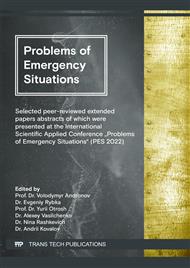p.53
p.63
p.69
p.77
p.87
p.105
p.115
p.125
p.131
Theoretical Prerequisites for Creating a Fire-Extinguishing Solution Based on Water-Absorbing Polymer Ecoflocf-07 for Extinguishing Fires in Ecosystems
Abstract:
Extinguishing fires in ecosystems has features compared to extinguishing fires in residential and industrial buildings, due to the composition and structure of combustible materials, which can form many foci of smoldering and have the ability to re-ignite, have a relatively low fire load compared to man-made ones. All this leads to high costs of water for extinguishing, carrying out operations for additional extinguishing of fires that occur after the main extinguishing and sets special requirements for aqueous extinguishing agents for their extinguishing.The paper analyzes the current state of the availability and trends of development in the world and domestic practice of effective water extinguishing agents and technologies for their use. Possible ways to improve recipes and increase the efficiency of fire extinguishing substances are outlined, taking into account, first of all, the criteria of efficiency, economy and environmental friendliness.It is noted that the main direction of increasing the fire extinguishing capacity of water is to create combined fire extinguishing solutions that can combine several methods of extinguishing in one technological operation: cooling, isolation and inhibition, which, other things being equal, reduces fire extinguishing consumption and extinguishing efficiency. An integrated direction of increasing the fire-extinguishing capacity of water can be considered to increase the coefficient of active use of water by reducing the surface tension of the fire-extinguishing solution, increasing the wettability and viscosity of water by introducing appropriate additives, obtaining optimal droplet dispersion.
Info:
Periodical:
Pages:
87-104
Citation:
Online since:
July 2022
Price:
Сopyright:
© 2022 Trans Tech Publications Ltd. All Rights Reserved
Share:
Citation:



